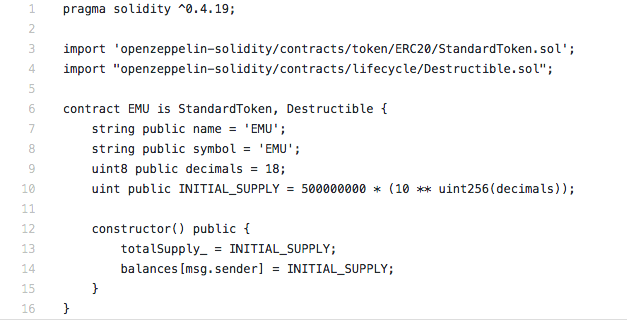What Is a Smart Contract? Part 2: Git On Up!
In Part 1 of this article, I described what a smart contract was and how it’s uniquely designed to replace unnecessary middlemen in transactions between an artist and her fans. I explained how traditional contracts create trust between buyer
and seller, but how in several key ways they create problems and
inefficiencies, especially notable in the music industry.
Now I’d like to show you what a smart contract is.
An image under the hood of EMU.
Above is an image of our first EMU smart contract, available on GitHub. It doesn’t look like much, but it shows you exactly what goes on in a typical transaction between buyer and seller.
- Line 1 tells you what language this contract is written in (we use Solidity).
- Lines 3-4 bring in a simple Solidity token file to show it as ERC-20 token compliant with Ethereum’s blockchain and that this token is completely under the control of its new owner and can be destroyed if he or she wants.
- Lines 6-10 reiterate the token’s status as standard and destructible, and add the name of the token, as well as how many decimal places it can be
carried out to (18 is standard) and the initial supply of the token at
the time of purchase. - Lines 12-14 show the constructor, which is public information about the token executed only once at the creation of the contract.
Certainly, some Smart Contracts are a more complicated, but only a little bit.
It’s our job here at eMusic to keep things simple. With that in mind,
we’ve distilled our efforts down into two distinct kinds of contracts
addressing the most important aspects of an artists’ career: Content and Sales.
Smart Contract 1: Content
The main use for the eMusic Content Smart Contract is to enable an artist
to publish an asset on the eMusic distribution platform for sale. Bill
Gates was correct in 1996 when he wrote, “Content is king.” Explaining
what that means, Gates said, “Content is where I expect much of the real money will be made on the Internet, just as it was in broadcasting.”
But, just like in broadcasting, you can’t make money off your content if you can’t control where it goes. That’s what eMusic’s Content Smart
Contract is all about. The artist/label will sign the Content Smart
Contract and the associated asset will receive an ID to be used in
reference to the platform and other Smart Contracts. With current
blockchain performance limitations, it would not be practical to simply
send the revenues to the right holders’ wallets automatically, this is
why we have opted for an ‘on-demand’ withdrawal mechanism. Rights
holders will access the Content Smart Contract to withdraw funds. The
Content Smart Contract itself contains no funds, rather is whitelisted
to withdraw funds from other Smart Contracts.
Smart Contract 2: Sales
So once you’ve regained control of your content, you’ve got to keep track
of your sales. As an existing music retailer, eMusic is in the unique
position to start testing all of our Smart Contracts from Day 1 of
launch. We can set precedent for future service providers to behave with our smart contracts and troubleshoot connections based on our existing
service provider business. Every time someone streams a new track it
gets recorded off-chain to a decentralized database containing music
asset IDs for all music. This means an artist could use our platform to
gather data on everywhere their song was streamed, downloaded, or
purchased in any other way. Once the simple process is complete, the
funds would be available for withdrawal to the rights holder.
Is there a third Smart Contract in the works? Stay tuned. Though the basis of our Blockchain is deceptively simple, the possibilities are endless.
If you have other ideas on how Smart Contracts could be implemented,
please let us know! Either leave them in the comments or email us at [email protected].
